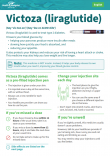Victoza
Key points about Victoza
- Victoza is used to treat type 2 diabetes.
- Victoza is also called liraglutide.
- Find out how to take it safely and possible side effects.

Victoza is used to treat type 2 diabetes. It lowers your blood glucose by helping your pancreas produce more insulin after meals. It also slows down how quickly food is absorbed and reduces your appetite.
Victoza also has other benefits. It can help with weight loss, protects your kidneys and heart, reduces your risk of having a heart attack and may also help you live longer. Victoza can be used alone or with some other diabetes medicines (eg, metformin, glipizide, gliclazide or insulin), along with healthy eating and regular exercise. Read more about type 2 diabetes.
Victoza is available as an injection given under your skin. In Aotearoa New Zealand Victoza is funded for type 2 diabetes, under a Special Authority, for people who meet the criteria. A special authority means your specialist will need to make an application to Pharmac (the government medicine funding agency) for approval before the medicine can be funded for you.
Victoza is not the same as insulin
Although Victoza is an injection, it is NOT insulin.
- Victoza helps your body to release its own insulin just when you need it, improving blood glucose control throughout the day.
- Unlike insulin it won't cause weight gain or low blood glucose levels (hypoglycaemia) when used alone.
Factsheet: How to take Victoza

|
Victoza (liraglutide) factsheet |
Video: How to take Victoza
(Healthify He Puna Waiora, NZ, 2023)
Descriptive transcript: How to take liraglutide. [PDF, 308 KB]
Watch how to take liraglutide(external link) in te reo Māori.
Victoza comes as a ready-to-use injection pen, which is pre-filled with the medicine. One pen has 30 doses of 0.6 mg, 15 doses of 1.2 mg or 10 doses of 1.8 mg.
Always use Victoza exactly as your healthcare provider has told you. The pharmacy label on your medicine will tell you how much to use, how often to take it and any special instructions. The following is a guide.
- The starting dose is 0.6 mg once a day, for at least one week.
- Your healthcare provider will tell you when to increase it to 1.2 mg once a day.
- Your healthcare provider may tell you to further increase the dose to 1.8 mg once a day if your blood glucose is not well controlled with a dose of 1.2 mg per day.
Don't change your dose unless your healthcare provider has told you to.
Victoza comes as a pen injection
Victoza comes as a ready-to-use injection pen, which is pre-filled with the medicine. One pen has 30 doses of 0.6 mg, 15 doses of 1.2 mg or 10 doses of 1.8 mg.
The Victoza pen has a dose selector that makes it easy for you to select your dose. If you selected a wrong dose by mistake, you can change it by turning the dose selector backwards or forwards until the right dose lines up with the pointer.
Use Victoza once a day
You can have your dose at any time of the day, with or without food. When you have found the most convenient time of the day, it's best to inject Victoza around the same time each day.
Victoza pens are not pre-fitted with needles
A needle has to be attached to the pen. Your pharmacist will advise you on the size and which needles are funded. Always use a new needle for each injection.
Change (rotate) your injection site each day
The best places to give yourself the injection are the front of your thighs, abdomen (tummy), or your upper arm.
Change (rotate) your injection site each day. You can use the same area of your body, but make sure you choose a different injection site in that area. Don't inject into skin that is sore, bruised, red, hard, scarred or skin that has stretch marks or psoriasis plaques.
If you forget your dose of Victoza
If you forget a dose, use Victoza as soon as you remember. However, if it's more than 12 hours since you should have used Victoza, skip the missed dose. Then take your next dose as usual the following day. Don't take an extra dose or increase the dose on the following day to make up for the missed dose.
Drink enough water to avoid dehydration
When starting Victoza, it can cause nausea (feeling sick), vomiting (being sick) and diarrhoea (runny poo), that can last for a few days. This increases your risk of dehydration, which can cause serious kidney problems.
- Be sure to drink plenty of water or non-sugary beverages.
- Avoid alcohol, as it can affect your blood glucose.
- Contact your healthcare provider if you have ongoing nausea, vomiting and diarrhoea or get symptoms of dehydration such as headache, feeling lightheaded or dizzy, weakness, feeling very tired, no energy and peeing (urinating) less than usual.
If you are unwell
Most people tend to have raised blood glucose (hyperglycaemia) when they're unwell, so it's important to continue taking your diabetes medicine. Victoza doesn't usually cause problems if you're slightly unwell, but if you're dehydrated from vomiting and diarrhoea and not eating and drinking as usual, you can delay the next injection until you're better. Talk to your healthcare provider if you have any questions. Read more about sick day plans for people with type 2 diabetes.
Pregnancy and contraception
If you're pregnant, think you may be pregnant, or are planning to have a baby, ask your doctor for advice as Victoza is not currently recommended during pregnancy.
If you're sexually active and don't want to become pregnant, you should use effective means of contraception to avoid unplanned pregnancy. Read more about contraception.
How to store Victoza
- Before opening: Store Victoza in the fridge, in the original package. Do not freeze. If your pen has been frozen, do not use it.
- During use: You can keep the pen for 1 month at room temperature (below 30°C) or in a refrigerator (2°C to 8°C). Don't freeze it.
When you're not using the pen, keep the pen cap on to protect from light.
Get rid of your used needles safely
It's important to get rid of your used needles safely. Keep them out of reach of children and pets. It is best to put used needles into a sharps container you can buy from your pharmacy. A sharps container is made of hard plastic that has a tight-fitting lid so used needles and syringes can be stored safely.
Don't flush used needles down the toilet or put them in rubbish or recycle bins. Once your sharps container is full, take it to your pharmacy for safe disposal.
Read more about safe disposal of needles.
Like all medicines Victoza can cause side effects, although not everyone gets them. If you're concerned about any symptoms you think might be related to your medicine, talk to your healthcare provider. The following information offers some guidance but doesn't include all possible side effects.
Common side effects
Tell your healthcare provider if these bother you.
- Reaction at the injection site such as bruising, redness, tenderness. Remember to change the injection site every day. You can use the same part of your body but try not to use exactly the same spot. Avoid injecting Victoza cold, because it's more likely to sting.
- Nausea (feeling sick), diarrhoea (runny poo), constipation, indigestion, gas or bloating. If you have diarrhoea or are dehydrated, delay your next dose until you feel better and you're eating and drinking normally.
- Headache, tiredness, dehydration, feeling thirsty. Make sure you are drinking enough water. If you are dehydrated, delay your next dose until you are eating and drinking normally.
Signs of low blood glucose (hypoglycaemia)
Signs include feeling weak, faint, dizzy or irritable. You may also get a headache, tremor (shakes) or blurred vision.
- Low blood glucose is very rare if you're taking Victoza alone, but if you're taking Victoza with other medicines for diabetes (eg, glipizide, gliclazide or insulin), there's a risk of low blood glucose.
- This is most likely to occur if you delay or miss a meal or snack, drink alcohol, exercise more than usual or can't eat because of nausea or vomiting.
- If this happens, drink something sweet such as a small glass of sweetened soft drink or fruit juice, or eat something sweet such as lollies. Follow this up with a carbohydrate snack such as a sandwich.
- Tell your doctor or nurse if this happens.
- Read more about hypoglycaemia and diabetes sick day plans.
Tell your healthcare provider immediately or phone Healthline free on 0800 611 116 if these occur
- Signs of problems with your pancreas such as severe pain in your stomach (tummy area) or your back, with nausea and vomiting.
Phone 111 for an ambulance or go to your nearest accident and emergency (A&E) clinic if these occur
- Signs of an allergic reaction such as itchy skin, and rash, swollen lips or tongue, problems breathing, such as a tight chest or shortness of breath.
Read more about medicines and side effects and reporting a reaction you think might be a side effect.
Victoza(external link) Medsafe Consumer Information Sheet
Brochures
Victoza (liraglutide) factsheet [PDF, 331 KB] Health Navigator NZ, 2023 English [PDF, 331 KB], te reo Māori [PDF, 217 KB], Samoan [PDF, 188 KB], Tongan [PDF, 226 KB]
5 questions to ask about your medications(external link) Health Quality and Safety Commission, NZ, 2019 English(external link), te reo Māori(external link)
References
- Victoza(external link) Medsafe Datasheet
- GLP1 receptor agonists(external link) Ministry of Health and NZSSD
- Glucagon-like peptide-1 receptor agonists – stay hydrated(external link) Medsafe Prescriber Update, NZ, June 2025
Brochures

Victoza (liraglutide) factsheet
Healthify He Puna Waiora, NZ, 2023
English
Te reo Māori
Samoan
Tongan

Medicines and side effects
Healthify He Puna Waiora, NZ, 2024

Health Quality and Safety Commission, NZ, 2019 English, te reo Māori
Credits: Sandra Ponen, Pharmacist, Healthify He Puna Waiora. Healthify is brought to you by Health Navigator Charitable Trust.
Reviewed by: Angela Lambie, Pharmacist, Auckland
Last reviewed:





